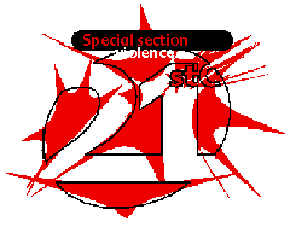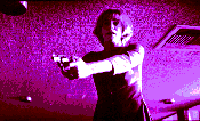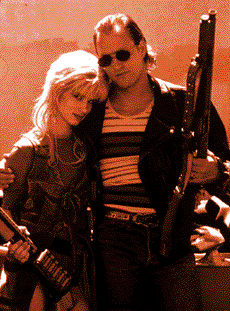

VIOLENCE
AND THE MEDIA:
The wrong controversy?
VIOLENCE IN POPULAR culture promises to be a central issue of the 1996 presidential campaign. The O.J. Simpson trial, R-rated films, and rap lyrics are coming to symbolize an issue that, like poverty or civil rights, incarnates an all-encompassing feeling about the quality of our civil lifea "sum of all evil," to borrow the elegant title abolitionists used for slavery.
The problem is that little in the present political discussion reflects the deep concerns people have about the subject. A case in point is last spring's policy statement by Sen. Bob Dole (R-Kan.), blaming the media for a breakdown of "traditional values." In response, entertainment industry spokespeople shifted responsibility to the public, saying that audiences, not movie makers, pick hits. In the view of studios, the car crashes, explosions, conspiracy theories, and serial killers currently assaulting local cineplex screens are only a common-sense response to marketing surveys and focus groups.
Dole's performance was equally cynical. He chastised everyone in Hollywood, a well-known Democratic town, except for a few select members, all of whom happened to be Republican stalwarts; he lauded "True Lies," a Schwartzenegger big-budget action-adventure film with more than its share of destruction. But the thrust of his argument deserves some examination.
The best instance of this is, curiously, something never mentioned in the current conversations: Vietnam. This war unalterably raised the acceptable threshold of violence on television; the famous images of horrorthe dead at My Lai, the Vietcong prisoner shot on camera by a South Vietnamese army officer, the napalm-singed little girl running naked down a roadprepared audiences for the fictional carnage later depicted in such television shows as "NYPD Blue" and "ER."
The suggestion that the media influence violence starts the discussion but does not end it. Issues of censorship and artistic expression immediately arise: Should news be censored in the name of preventing violence? What about the artistic functions of the portrayal of violence? An episode of the television show "Homicide" centered around a child accused of a playground killing. In the climactic scene, detectives arrested the boy as he threatened to commit suicide with his own gun. The image was horrifying and riveting, and it might have given a real kid a bad idea. But its shock was part of its artistry; the scene captured the pathos and terror of children whose deaths have filled the media for the past five years. And this example doesn't touch on more basic artistic uses of violence: The moment when rationality fails and a character throws him- or herself into action is a crucial option for a dramatist. The realistic portrayal of violence is one of the distinguishing marks of great artists from Cervantes to Willa Cather.
Finally, the causal argument overlooks other obvious, though less politically rewarding, factors. Violence in America has been inextricably linked to economic changes. The economic hardships of the 1930s and the late 1970s resulted in the highest homicide levels in this century. This relation persists today. The basis for a breakdown in family values that Dole and others bemoan is a material condition, not simply spiritual or artistic: It corresponds to deindustrialization. Rates of criminal violence have dropped significantly over the past 10 years, except among the young, the part of the population most affected by the current nationwide squeeze on jobs, income, and opportunity.
"We think the economic security of the period of World War II to the 70s is the norm," Foner says. "Actually, that period of stability was the exception. If you go back you'll find that industrialization created as much chaos as deindustrialization is creating now. But then at least you had the possibility of jobs. Now you don't have that. You might almost say we're going back to a normal period, but without the jobs and social institutions that took kids off the streets."
The "traditional values" extolled by politicians are vanishing because the economy that supported them is changing. The media both reflect and contribute to this historic transition. Public discourse about violence should include exploration, not merely exploitation, of those changes.
 Dole's claim that the media cause violence has a long pedigree. Episodes of violence in the pastthe rule, not the exception, in the American experiencehave always been linked to some social change. Dole's charges were only the latest variation of analyses that have attributed violence to slavery, the frontier, and labor conflicts. "It's important to avoid suggesting there was some golden age that we're falling short of," says Eric Foner, Columbia's DeWitt Clinton Professor of History. "Violence is pervasive in our history: political violence, ethnic violence, class violence. You go back to the KKK, you have people committing incredible acts of violence on a grand scale. What is different is the reach of the media. You can now put anything on the screen; there's no longer a sense of things being off limits."
Dole's claim that the media cause violence has a long pedigree. Episodes of violence in the pastthe rule, not the exception, in the American experiencehave always been linked to some social change. Dole's charges were only the latest variation of analyses that have attributed violence to slavery, the frontier, and labor conflicts. "It's important to avoid suggesting there was some golden age that we're falling short of," says Eric Foner, Columbia's DeWitt Clinton Professor of History. "Violence is pervasive in our history: political violence, ethnic violence, class violence. You go back to the KKK, you have people committing incredible acts of violence on a grand scale. What is different is the reach of the media. You can now put anything on the screen; there's no longer a sense of things being off limits."
 In addition, attempts to prove that the media causerather than simply influencebehavior are hopelessly inconclusive. First, the question of what constitutes violence is arguable. Studies quantifying the extent of violence on television notoriously group together shows as different as "Cops" and "Bugs Bunny." Television is also so pervasive that it's hard to locate people who have lived without it and can serve as a control group. The one study that scientifically measured rates of violence before and after the introduction of television had to use South Africa as its test case, since the apartheid state had banned television until the mid-1970s.(1)
In addition, attempts to prove that the media causerather than simply influencebehavior are hopelessly inconclusive. First, the question of what constitutes violence is arguable. Studies quantifying the extent of violence on television notoriously group together shows as different as "Cops" and "Bugs Bunny." Television is also so pervasive that it's hard to locate people who have lived without it and can serve as a control group. The one study that scientifically measured rates of violence before and after the introduction of television had to use South Africa as its test case, since the apartheid state had banned television until the mid-1970s.(1)
PHOTO CREDITS: EVERETT COLLECTION
Centerwall, Brandon S. "Exposure to Television as a Risk Factor for Violence." American Journal of Epidemiology 1989;129(4):643-652.
LEWIS COLE is chairman of the film division in Columbia's School of the Arts, reviews television for The Nation, and is co-author, with David Hilliard, of This Side of Glory: The Autobiography of David Hilliard and the Story of the Black Panther Party (Boston: Little, Brown, 1993).




